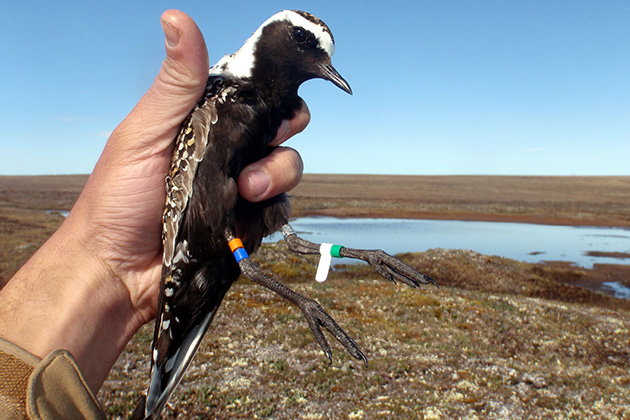
This time of year, many in the country are watching warily as pollen floats far and wide on the wind, enabling plants to reproduce but also causing sneezes and watery eyes.
But a new study out of the University of Connecticut demonstrates for the first time how some plants travel not just across the backyard, but as far as from Northern to Southern hemispheres on the wings of migratory birds.
The findings, published in the online journal PeerJ, offer critical insight into the ecology and evolution of plants that are represented across both continents of the Americas.
Led by Lily Lewis, a Ph.D. student in the Department of Ecology and Evolutionary Biology, the study found 23 regenerative plant diaspores – plant seeds or spores – trapped in the feathers of migratory birds leaving the Arctic harbor for South America.
“Scientists have always assumed that birds might be responsible for dispersing the seeds,” says Emily Behling ’15 (CLAS), a UConn undergraduate who contributed to the study. “But this bugged Lily. She wanted to know what was really going on.”
Although wind is the primary means for long-distance dispersal of diaspores around the world, it is an unlikely candidate for explaining distribution between the hemispheres. Yet previous evidence of birds dispersing plant seeds or spores across the tropics had been only circumstantial.

The researchers studied American golden plovers, semipalmated sandpipers, and red phalaropes – all birds that breed in coastal tundra. Many of the plant parts found in their feathers belonged to mosses, which are especially hardy plants and often need only one dispersal event to establish in a new place, says Lewis.
The behavior of these migrant birds in their northern breeding grounds likely promotes their inadvertent acquisition of diaspores, according to the study. Shallow nests are constructed by scraping depressions into the ground with breast, feet, and beaks, and are commonly lined with plant materials.
The timing of molt and migratory behavior also increases the likelihood of attached diaspores being dispersed across the birds’ migratory range.

The post-migratory molt and terrestrial destinations of American golden plovers and semipalmated sandpipers are compatible with the requirements for dispersal across the equator. The majority of migratory shorebirds with non-breeding grounds in the Southern Hemisphere provide similar opportunities for diaspore dispersal, with the molt typically occurring on the southern non-breeding grounds.
Funding for the research came from University of Connecticut Katie Bu Memorial Fund, a Switzer Environmental Fellowship awarded to Lewis, and the National Science Foundation.
This summer, Behling will present the study findings at the national Evolution 2014 conference in North Carolina.
Behling also plans to continue the research by examining the DNA of the plant particles found in the feathers to learn more about the plants that are being dispersed by the migratory birds.


